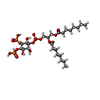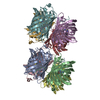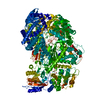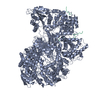+ データを開く
データを開く
- 基本情報
基本情報
| 登録情報 | データベース: EMDB / ID: EMD-0275 | |||||||||||||||||||||||||||
|---|---|---|---|---|---|---|---|---|---|---|---|---|---|---|---|---|---|---|---|---|---|---|---|---|---|---|---|---|
| タイトル | CryoEM structure of human full-length alpha1beta3gamma2L GABA(A)R in complex with picrotoxin and megabody Mb38. | |||||||||||||||||||||||||||
 マップデータ マップデータ | Synaptic human full-length a1b3g2L GABAAR in complex with picrotoxin and megabody Mb38. Sharpened and filtered map (Relion post-processing). | |||||||||||||||||||||||||||
 試料 試料 |
| |||||||||||||||||||||||||||
 キーワード キーワード | GABAAR / PTX / Membrane / Channel / Nanobody / Megabody / Cys-loop / PLGIC / Inhibition / Signalling / CNS / Neurons / Chloride / Ion / GABA / Picrotoxin / MEMBRANE PROTEIN | |||||||||||||||||||||||||||
| 機能・相同性 |  機能・相同性情報 機能・相同性情報GABA receptor activation / benzodiazepine receptor activity / circadian sleep/wake cycle, REM sleep / reproductive behavior / hard palate development / cellular response to histamine / GABA receptor activation / inner ear receptor cell development / GABA-A receptor activity / GABA-gated chloride ion channel activity ...GABA receptor activation / benzodiazepine receptor activity / circadian sleep/wake cycle, REM sleep / reproductive behavior / hard palate development / cellular response to histamine / GABA receptor activation / inner ear receptor cell development / GABA-A receptor activity / GABA-gated chloride ion channel activity / GABA-A receptor complex / inhibitory synapse assembly / innervation / response to anesthetic / postsynaptic specialization membrane / inhibitory postsynaptic potential / gamma-aminobutyric acid signaling pathway / synaptic transmission, GABAergic / cellular response to zinc ion / exploration behavior / chloride channel activity / motor behavior / adult behavior / roof of mouth development / cochlea development / Signaling by ERBB4 / social behavior / chloride channel complex / dendrite membrane / cytoplasmic vesicle membrane / chloride transmembrane transport / cerebellum development / post-embryonic development / learning / transmitter-gated monoatomic ion channel activity involved in regulation of postsynaptic membrane potential / GABA-ergic synapse / memory / dendritic spine / postsynaptic membrane / postsynapse / response to xenobiotic stimulus / axon / cell surface / signal transduction / identical protein binding / plasma membrane 類似検索 - 分子機能 | |||||||||||||||||||||||||||
| 生物種 |  Homo sapiens (ヒト) / Homo sapiens (ヒト) /   | |||||||||||||||||||||||||||
| 手法 | 単粒子再構成法 / クライオ電子顕微鏡法 / 解像度: 3.1 Å | |||||||||||||||||||||||||||
 データ登録者 データ登録者 | Masiulis S / Desai R | |||||||||||||||||||||||||||
| 資金援助 |  英国, 英国,  スイス, スイス,  米国, 8件 米国, 8件
| |||||||||||||||||||||||||||
 引用 引用 |  ジャーナル: Nature / 年: 2019 ジャーナル: Nature / 年: 2019タイトル: GABA receptor signalling mechanisms revealed by structural pharmacology. 著者: Simonas Masiulis / Rooma Desai / Tomasz Uchański / Itziar Serna Martin / Duncan Laverty / Dimple Karia / Tomas Malinauskas / Jasenko Zivanov / Els Pardon / Abhay Kotecha / Jan Steyaert / ...著者: Simonas Masiulis / Rooma Desai / Tomasz Uchański / Itziar Serna Martin / Duncan Laverty / Dimple Karia / Tomas Malinauskas / Jasenko Zivanov / Els Pardon / Abhay Kotecha / Jan Steyaert / Keith W Miller / A Radu Aricescu /     要旨: Type-A γ-aminobutyric (GABA) receptors are ligand-gated chloride channels with a very rich pharmacology. Some of their modulators, including benzodiazepines and general anaesthetics, are among the ...Type-A γ-aminobutyric (GABA) receptors are ligand-gated chloride channels with a very rich pharmacology. Some of their modulators, including benzodiazepines and general anaesthetics, are among the most successful drugs in clinical use and are common substances of abuse. Without reliable structural data, the mechanistic basis for the pharmacological modulation of GABA receptors remains largely unknown. Here we report several high-resolution cryo-electron microscopy structures in which the full-length human α1β3γ2L GABA receptor in lipid nanodiscs is bound to the channel-blocker picrotoxin, the competitive antagonist bicuculline, the agonist GABA (γ-aminobutyric acid), and the classical benzodiazepines alprazolam and diazepam. We describe the binding modes and mechanistic effects of these ligands, the closed and desensitized states of the GABA receptor gating cycle, and the basis for allosteric coupling between the extracellular, agonist-binding region and the transmembrane, pore-forming region. This work provides a structural framework in which to integrate previous physiology and pharmacology research and a rational basis for the development of GABA receptor modulators. | |||||||||||||||||||||||||||
| 履歴 |
|
- 構造の表示
構造の表示
| ムービー |
 ムービービューア ムービービューア |
|---|---|
| 構造ビューア | EMマップ:  SurfView SurfView Molmil Molmil Jmol/JSmol Jmol/JSmol |
| 添付画像 |
- ダウンロードとリンク
ダウンロードとリンク
-EMDBアーカイブ
| マップデータ |  emd_0275.map.gz emd_0275.map.gz | 5.8 MB |  EMDBマップデータ形式 EMDBマップデータ形式 | |
|---|---|---|---|---|
| ヘッダ (付随情報) |  emd-0275-v30.xml emd-0275-v30.xml emd-0275.xml emd-0275.xml | 28.3 KB 28.3 KB | 表示 表示 |  EMDBヘッダ EMDBヘッダ |
| 画像 |  emd_0275.png emd_0275.png | 190.9 KB | ||
| Filedesc metadata |  emd-0275.cif.gz emd-0275.cif.gz | 8.5 KB | ||
| その他 |  emd_0275_additional.map.gz emd_0275_additional.map.gz emd_0275_half_map_1.map.gz emd_0275_half_map_1.map.gz emd_0275_half_map_2.map.gz emd_0275_half_map_2.map.gz | 49.7 MB 49.8 MB 49.8 MB | ||
| アーカイブディレクトリ |  http://ftp.pdbj.org/pub/emdb/structures/EMD-0275 http://ftp.pdbj.org/pub/emdb/structures/EMD-0275 ftp://ftp.pdbj.org/pub/emdb/structures/EMD-0275 ftp://ftp.pdbj.org/pub/emdb/structures/EMD-0275 | HTTPS FTP |
-検証レポート
| 文書・要旨 |  emd_0275_validation.pdf.gz emd_0275_validation.pdf.gz | 752.8 KB | 表示 |  EMDB検証レポート EMDB検証レポート |
|---|---|---|---|---|
| 文書・詳細版 |  emd_0275_full_validation.pdf.gz emd_0275_full_validation.pdf.gz | 752.4 KB | 表示 | |
| XML形式データ |  emd_0275_validation.xml.gz emd_0275_validation.xml.gz | 12.7 KB | 表示 | |
| CIF形式データ |  emd_0275_validation.cif.gz emd_0275_validation.cif.gz | 14.3 KB | 表示 | |
| アーカイブディレクトリ |  https://ftp.pdbj.org/pub/emdb/validation_reports/EMD-0275 https://ftp.pdbj.org/pub/emdb/validation_reports/EMD-0275 ftp://ftp.pdbj.org/pub/emdb/validation_reports/EMD-0275 ftp://ftp.pdbj.org/pub/emdb/validation_reports/EMD-0275 | HTTPS FTP |
-関連構造データ
- リンク
リンク
| EMDBのページ |  EMDB (EBI/PDBe) / EMDB (EBI/PDBe) /  EMDataResource EMDataResource |
|---|---|
| 「今月の分子」の関連する項目 |
- マップ
マップ
| ファイル |  ダウンロード / ファイル: emd_0275.map.gz / 形式: CCP4 / 大きさ: 64 MB / タイプ: IMAGE STORED AS FLOATING POINT NUMBER (4 BYTES) ダウンロード / ファイル: emd_0275.map.gz / 形式: CCP4 / 大きさ: 64 MB / タイプ: IMAGE STORED AS FLOATING POINT NUMBER (4 BYTES) | ||||||||||||||||||||||||||||||||||||||||||||||||||||||||||||
|---|---|---|---|---|---|---|---|---|---|---|---|---|---|---|---|---|---|---|---|---|---|---|---|---|---|---|---|---|---|---|---|---|---|---|---|---|---|---|---|---|---|---|---|---|---|---|---|---|---|---|---|---|---|---|---|---|---|---|---|---|---|
| 注釈 | Synaptic human full-length a1b3g2L GABAAR in complex with picrotoxin and megabody Mb38. Sharpened and filtered map (Relion post-processing). | ||||||||||||||||||||||||||||||||||||||||||||||||||||||||||||
| 投影像・断面図 | 画像のコントロール
画像は Spider により作成 | ||||||||||||||||||||||||||||||||||||||||||||||||||||||||||||
| ボクセルのサイズ | X=Y=Z: 1.055 Å | ||||||||||||||||||||||||||||||||||||||||||||||||||||||||||||
| 密度 |
| ||||||||||||||||||||||||||||||||||||||||||||||||||||||||||||
| 対称性 | 空間群: 1 | ||||||||||||||||||||||||||||||||||||||||||||||||||||||||||||
| 詳細 | EMDB XML:
CCP4マップ ヘッダ情報:
| ||||||||||||||||||||||||||||||||||||||||||||||||||||||||||||
-添付データ
-追加マップ: Unsharpened map
| ファイル | emd_0275_additional.map | ||||||||||||
|---|---|---|---|---|---|---|---|---|---|---|---|---|---|
| 注釈 | Unsharpened map | ||||||||||||
| 投影像・断面図 |
| ||||||||||||
| 密度ヒストグラム |
-ハーフマップ: Half-map 2
| ファイル | emd_0275_half_map_1.map | ||||||||||||
|---|---|---|---|---|---|---|---|---|---|---|---|---|---|
| 注釈 | Half-map 2 | ||||||||||||
| 投影像・断面図 |
| ||||||||||||
| 密度ヒストグラム |
-ハーフマップ: Half-map 1
| ファイル | emd_0275_half_map_2.map | ||||||||||||
|---|---|---|---|---|---|---|---|---|---|---|---|---|---|
| 注釈 | Half-map 1 | ||||||||||||
| 投影像・断面図 |
| ||||||||||||
| 密度ヒストグラム |
- 試料の構成要素
試料の構成要素
-全体 : Human full-length heteromeric alpha1beta3gamma2L GABA(A)R in comp...
| 全体 | 名称: Human full-length heteromeric alpha1beta3gamma2L GABA(A)R in complex with picrotoxin and megabody Mb38. |
|---|---|
| 要素 |
|
-超分子 #1: Human full-length heteromeric alpha1beta3gamma2L GABA(A)R in comp...
| 超分子 | 名称: Human full-length heteromeric alpha1beta3gamma2L GABA(A)R in complex with picrotoxin and megabody Mb38. タイプ: complex / ID: 1 / 親要素: 0 / 含まれる分子: #1-#4 |
|---|---|
| 分子量 | 理論値: 330 KDa |
-超分子 #2: Human full-length heteromeric alpha1beta3gamma2L GABA(A)R in comp...
| 超分子 | 名称: Human full-length heteromeric alpha1beta3gamma2L GABA(A)R in complex with picrotoxin and megabody Mb38. タイプ: complex / ID: 2 / 親要素: 1 / 含まれる分子: #1-#3 |
|---|---|
| 由来(天然) | 生物種:  Homo sapiens (ヒト) / 器官: Brain / 細胞中の位置: Plasma membrane Homo sapiens (ヒト) / 器官: Brain / 細胞中の位置: Plasma membrane |
-超分子 #3: Human full-length heteromeric alpha1beta3gamma2L GABA(A)R in comp...
| 超分子 | 名称: Human full-length heteromeric alpha1beta3gamma2L GABA(A)R in complex with picrotoxin and megabody Mb38. タイプ: complex / ID: 3 / 親要素: 1 / 含まれる分子: #4 |
|---|---|
| 由来(天然) | 生物種:  |
-分子 #1: Gamma-aminobutyric acid receptor subunit alpha-1
| 分子 | 名称: Gamma-aminobutyric acid receptor subunit alpha-1 / タイプ: protein_or_peptide / ID: 1 詳細: Potential signal peptide: MKKSPGLSDY LWAWTLFLST LTGRSYG FLAG tag: DYKDDDDK コピー数: 2 / 光学異性体: LEVO |
|---|---|
| 由来(天然) | 生物種:  |
| 分子量 | 理論値: 49.85209 KDa |
| 組換発現 | 生物種:  Homo sapiens (ヒト) Homo sapiens (ヒト) |
| 配列 | 文字列: DYKDDDDKQP SLQDELKDNT TVFTRILDRL LDGYDNRLRP GLGERVTEVK TDIFVTSFGP VSDHDMEYTI DVFFRQSWKD ERLKFKGPM TVLRLNNLMA SKIWTPDTFF HNGKKSVAHN MTMPNKLLRI TEDGTLLYTM RLTVRAECPM HLEDFPMDAH A CPLKFGSY ...文字列: DYKDDDDKQP SLQDELKDNT TVFTRILDRL LDGYDNRLRP GLGERVTEVK TDIFVTSFGP VSDHDMEYTI DVFFRQSWKD ERLKFKGPM TVLRLNNLMA SKIWTPDTFF HNGKKSVAHN MTMPNKLLRI TEDGTLLYTM RLTVRAECPM HLEDFPMDAH A CPLKFGSY AYTRAEVVYE WTREPARSVV VAEDGSRLNQ YDLLGQTVDS GIVQSSTGEY VVMTTHFHLK RKIGYFVIQT YL PCIMTVI LSQVSFWLNR ESVPARTVFG VTTVLTMTTL SISARNSLPK VAYATAMDWF IAVCYAFVFS ALIEFATVNY FTK RGYAWD GKSVVPEKPK KVKDPLIKKN NTYAPTATSY TPNLARGDPG LATIAKSATI EPKEVKPETK PPEPKKTFNS VSKI DRLSR IAFPLLFGIF NLVYWATYLN REPQLKAPTP HQ UniProtKB: Gamma-aminobutyric acid receptor subunit alpha-1 |
-分子 #2: Gamma-aminobutyric acid receptor subunit beta-3
| 分子 | 名称: Gamma-aminobutyric acid receptor subunit beta-3 / タイプ: protein_or_peptide / ID: 2 / コピー数: 2 / 光学異性体: LEVO |
|---|---|
| 由来(天然) | 生物種:  Homo sapiens (ヒト) Homo sapiens (ヒト) |
| 分子量 | 理論値: 54.444578 KDa |
| 組換発現 | 生物種:  Homo sapiens (ヒト) Homo sapiens (ヒト) |
| 配列 | 文字列: MCSGLLELLL PIWLSWTLGT RGSEPRSVND PGNMSFVKET VDKLLKGYDI RLRPDFGGPP VCVGMNIDIA SIDMVSEVNM DYTLTMYFQ QYWRDKRLAY SGIPLNLTLD NRVADQLWVP DTYFLNDKKS FVHGVTVKNR MIRLHPDGTV LYGLRITTTA A CMMDLRRY ...文字列: MCSGLLELLL PIWLSWTLGT RGSEPRSVND PGNMSFVKET VDKLLKGYDI RLRPDFGGPP VCVGMNIDIA SIDMVSEVNM DYTLTMYFQ QYWRDKRLAY SGIPLNLTLD NRVADQLWVP DTYFLNDKKS FVHGVTVKNR MIRLHPDGTV LYGLRITTTA A CMMDLRRY PLDEQNCTLE IESYGYTTDD IEFYWRGGDK AVTGVERIEL PQFSIVEHRL VSRNVVFATG AYPRLSLSFR LK RNIGYFI LQTYMPSILI TILSWVSFWI NYDASAARVA LGITTVLTMT TINTHLRETL PKIPYVKAID MYLMGCFVFV FLA LLEYAF VNYIFFGRGP QRQKKLAEKT AKAKNDRSKS ESNRVDAHGN ILLTSLEVHN EMNEVSGGIG DTRNSAISFD NSGI QYRKQ SMPREGHGRF LGDRSLPHKK THLRRRSSQL KIKIPDLTDV NAIDRWSRIV FPFTFSLFNL VYWLYYVN UniProtKB: Gamma-aminobutyric acid receptor subunit beta-3 |
-分子 #3: Gamma-aminobutyric acid receptor subunit gamma-2
| 分子 | 名称: Gamma-aminobutyric acid receptor subunit gamma-2 / タイプ: protein_or_peptide / ID: 3 / 詳細: Linker sequence: GGSGGSGGSGK 1D4 tag: TETSQVAPA / コピー数: 1 / 光学異性体: LEVO |
|---|---|
| 由来(天然) | 生物種:  Homo sapiens (ヒト) Homo sapiens (ヒト) |
| 分子量 | 理論値: 56.922055 KDa |
| 組換発現 | 生物種:  Homo sapiens (ヒト) Homo sapiens (ヒト) |
| 配列 | 文字列: MSSPNIWSTG SSVYSTPVFS QKMTVWILLL LSLYPGFTSQ KSDDDYEDYA SNKTWVLTPK VPEGDVTVIL NNLLEGYDNK LRPDIGVKP TLIHTDMYVN SIGPVNAINM EYTIDIFFAQ TWYDRRLKFN STIKVLRLNS NMVGKIWIPD TFFRNSKKAD A HWITTPNR ...文字列: MSSPNIWSTG SSVYSTPVFS QKMTVWILLL LSLYPGFTSQ KSDDDYEDYA SNKTWVLTPK VPEGDVTVIL NNLLEGYDNK LRPDIGVKP TLIHTDMYVN SIGPVNAINM EYTIDIFFAQ TWYDRRLKFN STIKVLRLNS NMVGKIWIPD TFFRNSKKAD A HWITTPNR MLRIWNDGRV LYTLRLTIDA ECQLQLHNFP MDEHSCPLEF SSYGYPREEI VYQWKRSSVE VGDTRSWRLY QF SFVGLRN TTEVVKTTSG DYVVMSVYFD LSRRMGYFTI QTYIPCTLIV VLSWVSFWIN KDAVPARTSL GITTVLTMTT LST IARKSL PKVSYVTAMD LFVSVCFIFV FSALVEYGTL HYFVSNRKPS KDKDKKKKNP LLRMFSFKAP TIDIRPRSAT IQMN NATHL QERDEEYGYE CLDGKDCASF FCCFEDCRTG AWRHGRIHIR IAKMDSYARI FFPTAFCLFN LVYWVSYLYL GGSGG SGGS GKTETSQVAP A UniProtKB: Gamma-aminobutyric acid receptor subunit gamma-2 |
-分子 #4: Megabody Mb38
| 分子 | 名称: Megabody Mb38 / タイプ: protein_or_peptide / ID: 4 / 詳細: 6His tag: HHHHHH EPEA tag: EPEA / コピー数: 1 / 光学異性体: LEVO |
|---|---|
| 由来(天然) | 生物種:  |
| 分子量 | 理論値: 57.784301 KDa |
| 組換発現 | 生物種:  |
| 配列 | 文字列: QVQLQESGGG LVQTKTTTSV IDTTNDAQNL LTQAQTIVNT LKDYCPILIA KSSSSNGGTN NANTPSWQTA GGGKNSCATF GAEFSAASD MINNAQKIVQ ETQQLSANQP KNITQPHNLN LNSPSSLTAL AQKMLKNAQS QAEILKLANQ VESDFNKLSS G HLKDYIGK ...文字列: QVQLQESGGG LVQTKTTTSV IDTTNDAQNL LTQAQTIVNT LKDYCPILIA KSSSSNGGTN NANTPSWQTA GGGKNSCATF GAEFSAASD MINNAQKIVQ ETQQLSANQP KNITQPHNLN LNSPSSLTAL AQKMLKNAQS QAEILKLANQ VESDFNKLSS G HLKDYIGK CDASAISSAN MTMQNQKNNW GNGCAGVEET QSLLKTSAAD FNNQTPQINQ AQNLANTLIQ ELGNNPFRAS GG GSGGGGS GKLSDTYEQL SRLLTNDNGT NSKTSAQAIN QAVNNLNERA KTLAGGTTNS PAYQATLLAL RSVLGLWNSM GYA VICGGY TKSPGENNQK DFHYTDENGN GTTINCGGST NSNGTHSYNG TNTLKADKNV SLSIEQYEKI HEAYQILSKA LKQA GLAPL NSKGEKLEAH VTTSKYGSLR VSCAASGRTF TTYIMAWFRQ APGKEREFLA AMDQGRIQYY GDSVRGRFTI SRDYA KNSV DLQLDGLRPE DTAVYYCAAG AGFWGLRTAS SYHYWGQGTQ VTVSSHHHHH HEPEA |
-分子 #9: [(2R)-2-octanoyloxy-3-[oxidanyl-[(1R,2R,3S,4R,5R,6S)-2,3,6-tris(o...
| 分子 | 名称: [(2R)-2-octanoyloxy-3-[oxidanyl-[(1R,2R,3S,4R,5R,6S)-2,3,6-tris(oxidanyl)-4,5-diphosphonooxy-cyclohexyl]oxy-phosphoryl]oxy-propyl] octanoate タイプ: ligand / ID: 9 / コピー数: 2 / 式: PIO |
|---|---|
| 分子量 | 理論値: 746.566 Da |
| Chemical component information |  ChemComp-PIO: |
-分子 #10: (1aR,2aR,3S,6R,6aS,8aS,8bR,9R)-2a-hydroxy-8b-methyl-9-(prop-1-en-...
| 分子 | 名称: (1aR,2aR,3S,6R,6aS,8aS,8bR,9R)-2a-hydroxy-8b-methyl-9-(prop-1-en-2-yl)hexahydro-3,6-methano-1,5,7-trioxacyclopenta[ij]c yclopropa[a]azulene-4,8(3H)-dione タイプ: ligand / ID: 10 / コピー数: 1 / 式: RI5 |
|---|---|
| 分子量 | 理論値: 292.284 Da |
-実験情報
-構造解析
| 手法 | クライオ電子顕微鏡法 |
|---|---|
 解析 解析 | 単粒子再構成法 |
| 試料の集合状態 | particle |
- 試料調製
試料調製
| 濃度 | 0.1 mg/mL |
|---|---|
| 緩衝液 | pH: 7.6 |
| グリッド | モデル: Quantifoil, UltrAuFoil, R1.2/1.3 / 材質: GOLD / メッシュ: 300 / 前処理 - タイプ: GLOW DISCHARGE / 前処理 - 時間: 45 sec. 詳細: 3.5 ul of 0.1 mg/ml protein solution was applied on a grid in the Vitrobot MkIV chamber set to 95% RH at 14.5 degC for 30s and then blotted for 5.5 s and plunged |
| 凍結 | 凍結剤: ETHANE / 装置: FEI VITROBOT MARK IV |
| 詳細 | Monodisperse sample |
- 電子顕微鏡法
電子顕微鏡法
| 顕微鏡 | FEI TITAN KRIOS |
|---|---|
| 特殊光学系 | 位相板: VOLTA PHASE PLATE |
| 撮影 | フィルム・検出器のモデル: FEI FALCON III (4k x 4k) 検出モード: COUNTING / 平均電子線量: 30.0 e/Å2 |
| 電子線 | 加速電圧: 300 kV / 電子線源:  FIELD EMISSION GUN FIELD EMISSION GUN |
| 電子光学系 | 照射モード: FLOOD BEAM / 撮影モード: BRIGHT FIELD / Cs: 2.7 mm 最大 デフォーカス(公称値): 0.7000000000000001 µm 最小 デフォーカス(公称値): 0.5 µm / 倍率(公称値): 75000 |
| 試料ステージ | 試料ホルダーモデル: FEI TITAN KRIOS AUTOGRID HOLDER ホルダー冷却材: NITROGEN |
| 実験機器 |  モデル: Titan Krios / 画像提供: FEI Company |
+ 画像解析
画像解析
-原子モデル構築 1
| 精密化 | プロトコル: FLEXIBLE FIT |
|---|---|
| 得られたモデル |  PDB-6hug: |
 ムービー
ムービー コントローラー
コントローラー
























 Z (Sec.)
Z (Sec.) Y (Row.)
Y (Row.) X (Col.)
X (Col.)













































